Disclaimer: This article is for informational purposes only and does not replace professional veterinary advice. Always consult your veterinarian if you notice unusual symptoms in your pet.
Table of Contents
Introduction
Watching your dog losing hair can be both stressful and confusing. As a small-animal veterinarian, I frequently see pet parents walk into the clinic with clumps of fur in hand, anxiously asking, “Why is my dog losing hair like this?” It might begin with subtle thinning along the back or belly, or suddenly appear as obvious bald patches. Often, dog losing hair is linked to manageable issues like allergies, parasites, or poor nutrition, but it can also indicate deeper health problems such as hormonal imbalances or infections.
Pinpointing the exact cause isn’t always simple but with proper veterinary care, most cases can be diagnosed, treated, and reversed. This guide will walk you through the common causes, treatments, and prevention tips to help restore your dog’s healthy coat.
✅ Key Takeaways: Why Is Your Dog Losing Hair?
- Hair loss in dogs (alopecia) isn’t always serious, but it can signal allergies, parasites, infections, hormonal issues, or stress.
- “Dog losing hair” is one of the top 10 skin-related concerns in veterinary practice most cases are treatable with timely diagnosis.
- Veterinary care is essential to determine the true cause, especially when symptoms like itching, redness, or systemic changes appear.
- Preventive steps like regular grooming, a balanced diet, and year-round parasite control can protect your dog’s coat and skin.
- This article also covers a 5-minute home checklist, a Canadian cost guide, and a prevention plan to help keep your dog’s fur healthy and full.
Is It Normal Shedding or Something More?
You can also Visit: https://doglifeexpert.com/dog-seizures-in-2025-top-10-causes-treatments/
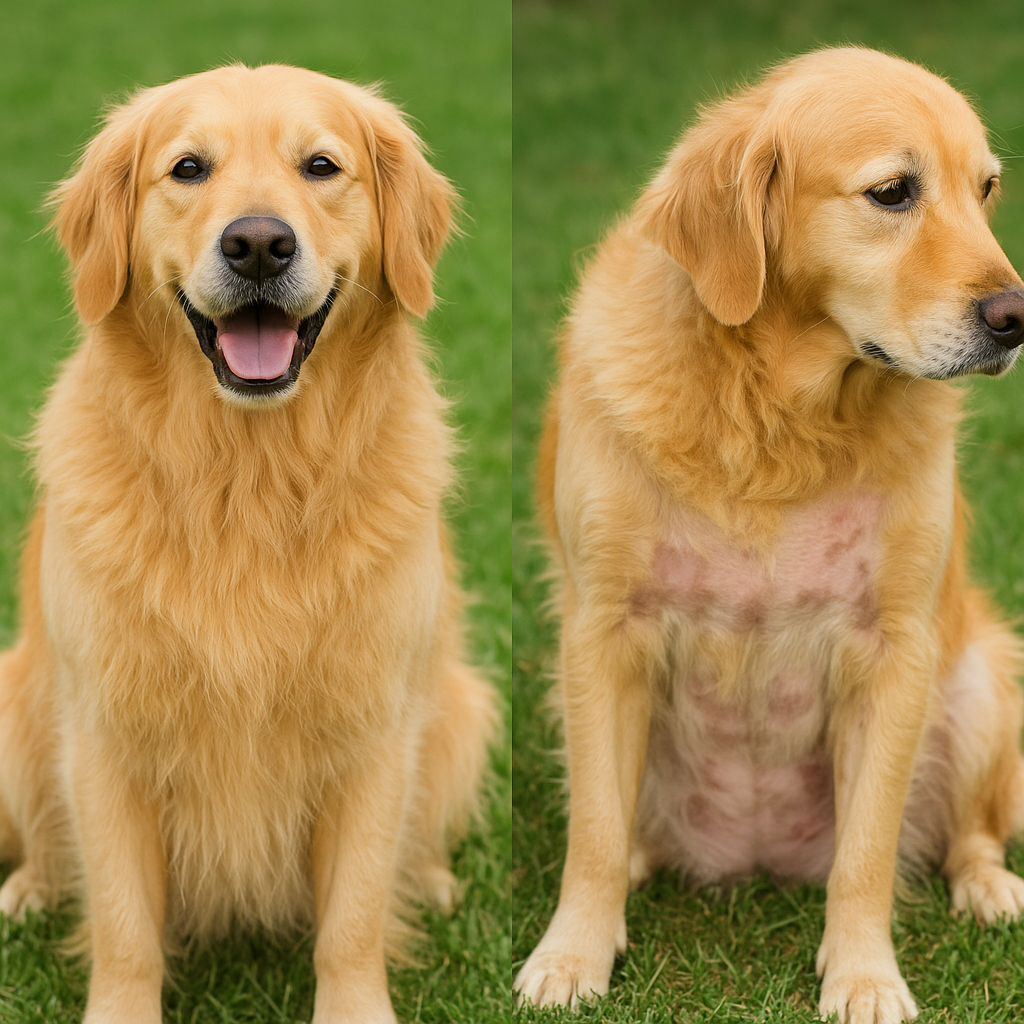
Dogs naturally shed as part of a healthy hair cycle but how do you know when it’s more than just seasonal fur fallout? As a vet, I often hear, “My dog is losing hair but not scratching is that okay?” Sometimes, it is. But in other cases, it may point to underlying skin issues or medical conditions.
Normal Shedding vs Alopecia
- Normal shedding happens year-round in some breeds, especially in Canadian climates where indoor heating can confuse seasonal cues.
- Dog losing hair abnormally often shows as bald spots, fur thinning, or uneven coat loss especially if it’s patchy or accompanied by itching or skin changes.
Watch for These Red Flags:
- Sudden or excessive hair loss in clumps
- Bald spots on the face, belly, or legs
- Red, flaky, or scabby skin
- Dog losing hair with weight changes or lethargy
🧪 5-Minute Home Checklist
Take 5 minutes to check your dog from nose to tail:
| What to Look For | Why It Matters |
|---|---|
| Bald spots or uneven patches | May indicate parasites, infection, or allergies |
| Red or inflamed skin | Often seen with allergies or bacterial infections |
| Scratching, licking, or biting | Suggests itchiness due to fleas, mites, or stress |
| Odour or greasy skin | Can point to yeast or seborrhea |
| Weight gain or lethargy | Common with hypothyroidism or hormonal issues |
If any of these signs are present along with your dog losing hair, it’s time to call your vet.
Common Causes of Hair Loss in Dogs
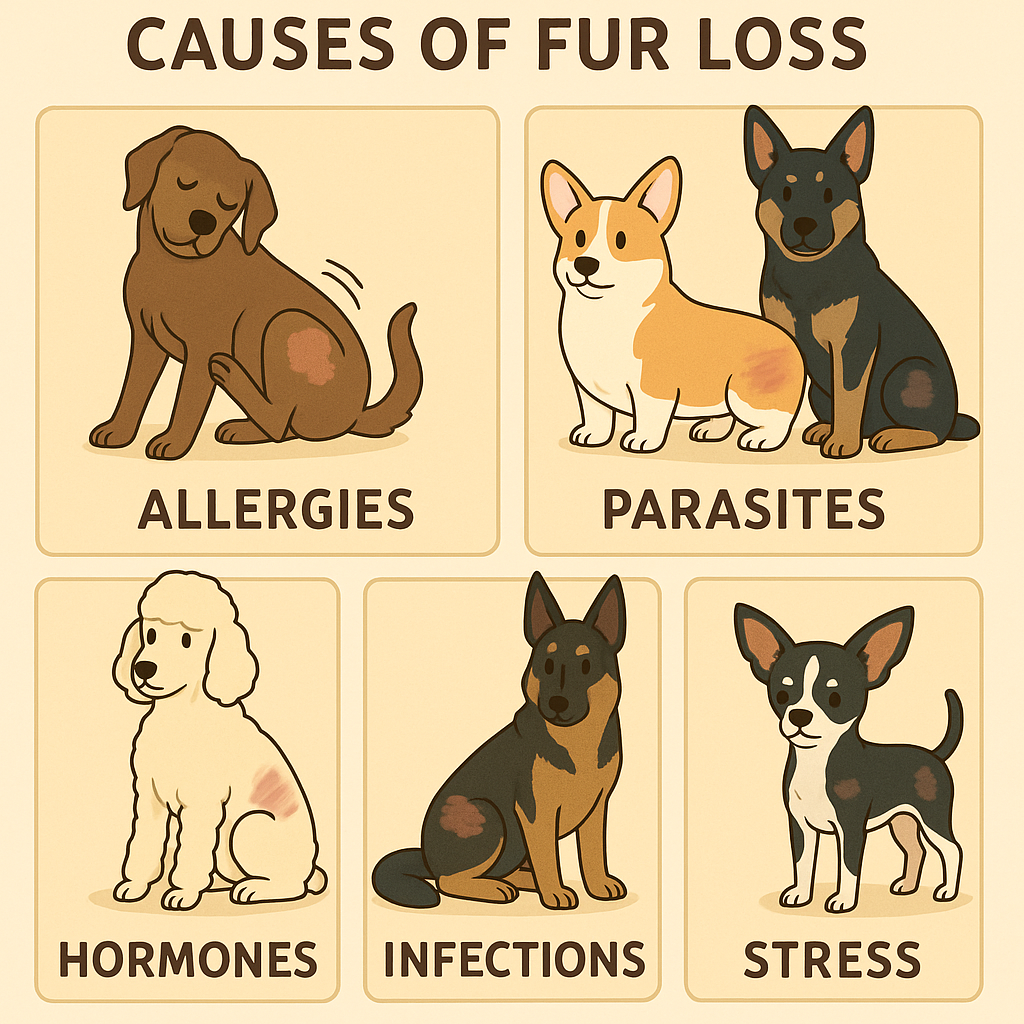
As a vet in Canada, I’ve diagnosed dozens of cases of dogs losing hair from flea infestations in Golden Retrievers to thyroid disease in overweight Labradors. Here are the top reasons your dog might be losing hair, how they show up, and what you should do about them.
1. Allergies: A Leading Cause of Dog Losing Hair
Allergies are one of the most common and frustrating reasons for a dog losing hair, and they’re also among the most misunderstood. Allergic reactions in dogs can result from food, environmental allergens, or flea bites and each type can lead to relentless itching, inflammation, and skin trauma. As the dog scratches, chews, or licks the irritated area, hair shafts break, skin becomes damaged, and bald patches begin to form.
In my veterinary practice, I often see dogs with chronic allergies that worsen seasonally or flare up after a dietary indiscretion. It’s not uncommon to see a dog losing hair from multiple areas: the belly, tail base, armpits, or around the ears especially if they have more than one type of allergy at play.
🔍 Common Types of Allergies
- Food Allergies
These typically develop over time and are most often linked to common proteins like chicken, beef, or dairy. Dogs may present with gastrointestinal issues (soft stool, vomiting) as well as skin signs like redness, recurrent ear infections, or a dog losing hair on the face, chest, or legs. Breeds like Labradors, French Bulldogs, and Cocker Spaniels are often affected. - Environmental Allergies (Atopic Dermatitis)
Atopic dogs react to airborne allergens like dust mites, grass, or pollen. Symptoms tend to be seasonal but may occur year-round indoors. You may notice your dog losing hair after walks in the grass or during pollen-heavy months. The hair loss is usually focused around the paws, muzzle, eyes, belly, or underarms. Breeds like West Highland White Terriers, Golden Retrievers, and Shih Tzus are genetically predisposed. - Flea Allergy Dermatitis (FAD)
FAD is an extreme allergic reaction to flea saliva. Even one flea bite can cause days of itching and result in your dog losing hair around the tail base, thighs, and lower back. In severe cases, dogs develop “hot spots” moist, infected areas caused by constant licking and biting.
🩺 Recognizable Symptoms:
- Persistent scratching, chewing, or rubbing against furniture
- Red or inflamed skin, especially near the paws, ears, and belly
- Recurrent ear or skin infections
- Chewed or stained fur from saliva (brown discoloration)
- Patchy or widespread hair loss
💊 Treatment & Management Options:
- Flea Control: Year-round flea prevention (e.g., Simparica Trio) is critical, especially if FAD is suspected.
- Diet Trials: An 8–12 week elimination trial using hydrolyzed or novel proteins (like venison or duck) is the gold standard for diagnosing food allergies.
- Medications: Apoquel, Cytopoint injections, or antihistamines help relieve itching. These can be used alone or in combination, depending on severity.
- Topical Relief: Oatmeal baths, medicated shampoos (chlorhexidine-based), and leave-in sprays can soothe inflamed skin.
Identifying the specific allergy type often requires testing or food trials, but with the right strategy, allergic dogs can live comfortable, happy lives. If you notice your dog losing hair, especially with signs of itching or skin redness, allergy management should be high on your list of possibilities.
2. Parasites
Fleas, mites, and lice are tiny but their impact is massive. If your dog is losing hair and scratching nonstop, parasites are high on the list.
Common Culprits:
- Fleas: Look for flea dirt (black specks) on your dog’s skin.
- Mites (Mange): Causes intense itch and patchy hair loss. Sarcoptic mange is contagious to humans.
- Lice: Rare, but possible. Causes rough coat and skin irritation.
Treatment: Vet-prescribed treatments like Revolution or Bravecto, deep cleaning of bedding and environment.
3. Infections
When skin is irritated, broken, or scratched raw, infections take hold leading to visible patches of dog losing hair.
Types:
- Bacterial Infections (Pyoderma): Often secondary to scratching.
- Fungal Infections (Ringworm): Circular bald patches, often scaly or crusty.
- Yeast Infections: Greasy skin, especially in skin folds (Bulldogs, Pugs).
Treatment: Topical shampoos, oral antibiotics, or antifungals. Don’t bathe your dog before a vet visit it could affect test results.
4. Hormonal Imbalances
Hair loss can be a red flag for underlying hormone issues, especially in middle-aged or older dogs.
Common Hormonal Causes:
- Hypothyroidism: Common in Golden Retrievers and Dobermans. Look for symmetrical baldness, weight gain, lethargy.
- Cushing’s Disease: Caused by too much cortisol. Skin thins, belly enlarges, and hair doesn’t grow back.
Treatment: Requires lifelong medication and regular blood monitoring.
5. Stress or Anxiety
Yes stress can cause a dog to lose hair, especially around the paws, flanks, or tail. I’ve seen dogs overgroom due to separation anxiety, boredom, or changes in the home.
Common Triggers:
- Moving homes
- New baby or pet
- Lack of stimulation
Signs: Localized hair loss, excessive licking, behavioral signs like pacing or whining.
Treatment: Calming supplements, behavior training, pheromone diffusers, or vet-prescribed anxiety meds.
6. Nutritional Deficiencies
A poor diet is another underrecognized reason for a dog losing hair. Deficiencies in zinc, biotin, vitamin A, or omega-3 fatty acids can cause dull coats and excessive shedding.
Risk Factors:
- Low-quality kibble
- Homemade diets without veterinary guidance
- Malabsorption disorders
Treatment: Switch to a balanced, vet-recommended dog food. Add omega-3 supplements (like Welactin Omega-3) as directed.
7. Skin Conditions
Dermatologic issues like seborrhea or pressure sores may lead to local fur loss.
- Seborrhea: Greasy or flaky skin. Common in Spaniels and Basset Hounds.
- Dry Skin: Especially in winter climates.
- Pressure Sores: Bald patches on elbows or hips from lying on hard surfaces.
Treatment: Moisturizing shampoos, vet-prescribed conditioners, padded bedding.
8. Autoimmune Disorders
Rare, but serious. Conditions like lupus or pemphigus cause the immune system to attack hair follicles.
Symptoms: Scabs, ulcers, crusting, symmetrical hair loss.
Treatment: Immunosuppressive therapy under strict veterinary supervision.
9. Genetic or Breed-Specific Causes
Some breeds are prone to baldness or have naturally sparse coats.
Examples:
- Chinese Crested, Xoloitzcuintli, American Hairless Terrier
- Pattern baldness in Dachshunds or Chihuahuas
These dogs may be born with less hair or develop breed-related hair loss with age.
10. Post-Grooming Alopecia
After a surgical shave or close clipping, some dogs especially double-coated breeds like Huskies develop patchy regrowth or temporary hair loss.
Treatment: Patience. Fur typically regrows in weeks to months unless follicle damage occurred.
How Vets Diagnose the Cause of Hair Loss
When a pet parent brings in a dog losing hair, our first step is to ask detailed questions. Is the hair loss sudden or gradual? Itchy or not? Any changes in behavior or appetite?
I once treated a Border Collie with bald patches that seemed like seasonal shedding. Bloodwork revealed hypothyroidism and with thyroid medication, his coat came back beautifully within a month.
Diagnostic Tools Used by Vets:
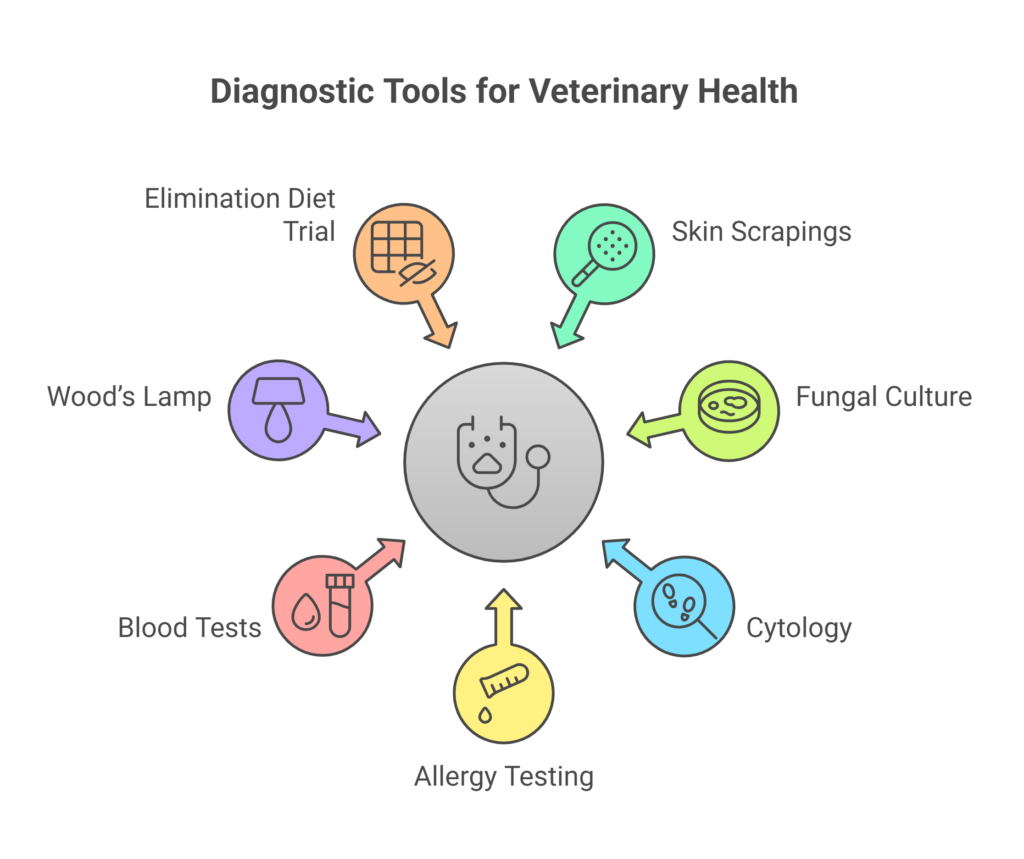
Diagnosing why your dog is losing hair isn’t always straightforward. Symptoms can overlap itching from allergies may mimic mange, and symmetrical hair loss could stem from hormones or genetics.
That’s why DIY solutions or over-the-counter shampoos often delay proper treatment. Getting the diagnosis right the first time saves time, money, and discomfort for your dog.
Treatment Options Based on the Cause

When your dog is losing hair, treatment depends entirely on the root cause. No one-size-fits-all fix exists what works for allergies won’t help with mites or thyroid disease.
Treatment Summary Table
| Cause | Treatment Options |
|---|---|
| Allergies | Hypoallergenic diets, antihistamines, Apoquel, Cytopoint, flea prevention |
| Parasites | Prescription flea/tick preventives (Simparica, Bravecto), environmental cleaning |
| Infections | Antibiotics, antifungal meds, medicated shampoos (e.g., chlorhexidine) |
| Hormonal Imbalance | Thyroid supplements, medications for Cushing’s, regular monitoring |
| Stress/Anxiety | Behavioral therapy, calming diffusers, enrichment, anti-anxiety meds (e.g., fluoxetine) |
| Nutritional Deficiency | Diet upgrade, omega-3 or biotin supplements |
| Skin Conditions | Medicated baths, moisturizers, soft bedding |
| Autoimmune Disorders | Immunosuppressants like prednisone under vet guidance |
| Genetic/Breed-Related | No treatment needed unless skin gets irritated |
| Post-Grooming Alopecia | No meds—just time and coat regrowth support |
How Long Does Recovery Take?
- Mild infections: 2–3 weeks with antibiotics or antifungals
- Flea or mite infestations: Hair starts returning in 1–2 months
- Thyroid or hormonal conditions: Noticeable improvement in 4–6 weeks, but lifelong treatment is typical
- Nutritional causes: 1–2 months after dietary changes
Never stop treatments without veterinary approval even if your dog losing hair starts regrowing fur. Relapse is common with incomplete care.
Typical Canadian Costs for Diagnosing and Treating Hair Loss
Helping a dog losing hair can involve several steps and the costs vary based on the condition and your location in Canada. Below is a breakdown of average veterinary expenses (CAD) to expect.
💰 Cost Guide: Hair Loss Diagnosis & Treatment in Canada
| Service | Average Cost (CAD) |
|---|---|
| Veterinary exam | $75 – $120 |
| Skin scraping or cytology | $40 – $90 |
| Fungal culture (for ringworm) | $60 – $100 |
| Bloodwork (CBC, thyroid panel) | $120 – $250 |
| Allergy testing (intradermal or IgE) | $300 – $600 |
| Diet trial (8-week hypoallergenic) | $150 – $350/month |
| Flea/tick medication (monthly) | $20 – $40/month |
| Antibiotics or antifungals (oral) | $40 – $120/course |
| Hormonal meds (thyroid, Cushing’s) | $30 – $150/month |
| Follow-up visit | $60 – $100 |
💡 Tip: Ask your vet if diagnostics can be staged to prioritize the most likely cause first especially helpful when working with a tight budget.
When your dog is losing hair, upfront costs can be intimidating. But treating early often saves hundreds in future complications or secondary infections.
How to Prevent Hair Loss in Dogs
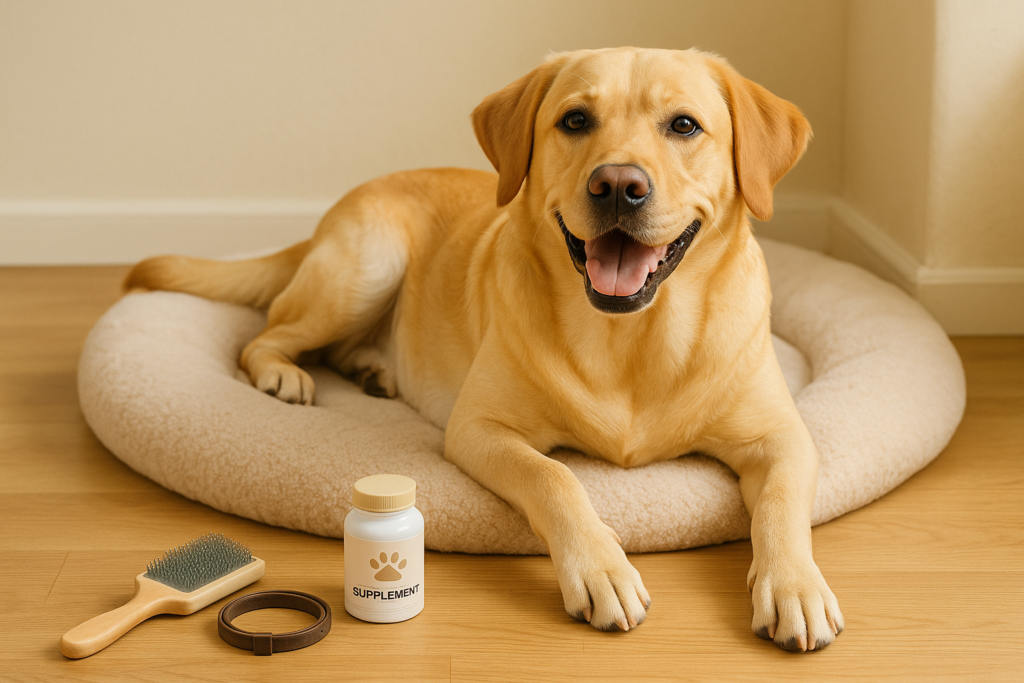
The best way to deal with a dog losing hair is to prevent it before it starts. Preventive care reduces the risk of allergies, parasites, and stress-related grooming behaviors all common culprits behind canine hair loss.
🧼 1. Regular Grooming
Brushing your dog 2–3 times per week removes dead fur, distributes natural oils, and helps you spot early signs of hair loss.
- Use a slicker brush for double-coated breeds
- Try a rubber curry brush for short-haired dogs
- Avoid shaving double coats they regulate body temperature and regrow poorly
🐛 2. Year-Round Parasite Control
Fleas, mites, and lice are among the most preventable causes of dog losing hair.
- Use monthly flea/tick preventives like Simparica Trio, NexGard, or Bravecto
- Clean bedding and vacuum carpets regularly
- If you visit dog parks or groomers often, consider parasite preventives even in winter
🥩 3. Feed a High-Quality Diet
Nutrition is foundational for a shiny coat and healthy skin.
- Choose foods rich in omega-3s, zinc, and vitamin E
- Avoid low-cost brands with fillers or meat by-products
- Consider adding fish oil supplements or skin-support chews (ask your vet)
🧠 4. Manage Stress and Anxiety
Many pet owners overlook emotional health as a reason for their dog losing hair.
- Provide toys, mental stimulation, and consistent routines
- Try calming pheromones (like Adaptil) or anxiety wraps
- For chronic anxiety, speak to your vet about behavioral therapy or medication
🩺 5. Schedule Regular Vet Visits
A wellness check every 6–12 months helps catch early signs of hormonal issues, infections, or nutrient deficiencies.
- Ask your vet to check thyroid levels in dogs over age 6
- Catching these issues early means better outcomes and less hair loss
When to See a Vet
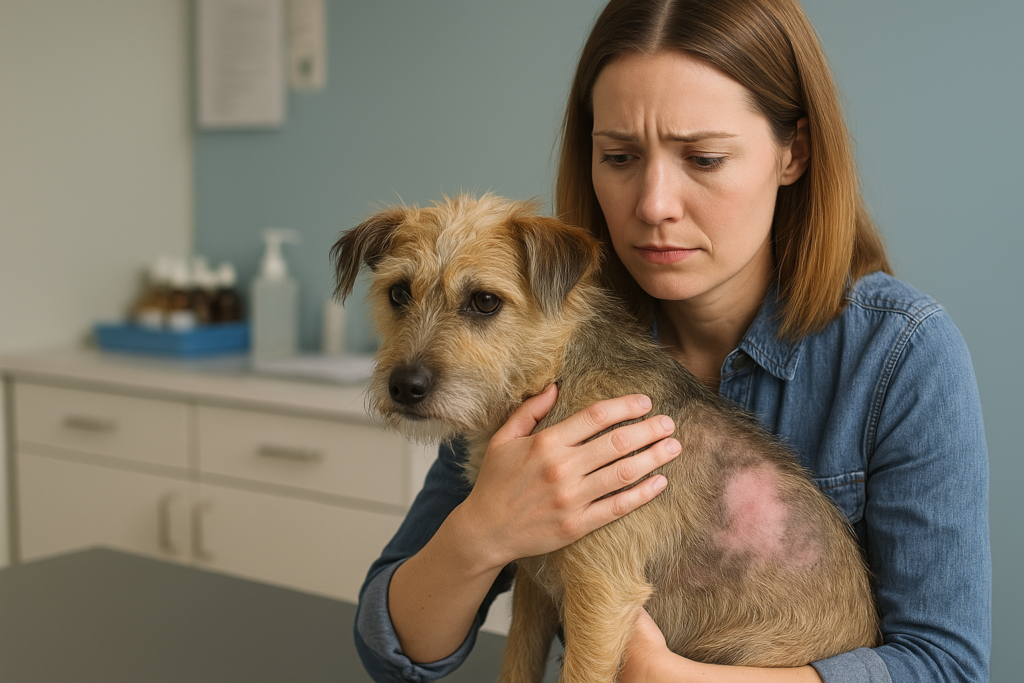
https://vcahospitals.com/know-your-pet/hair-loss-in-dogs
While some minor hair loss can be normal especially during seasonal shedding certain signs mean your dog losing hair should be examined by a veterinarian right away.
🚩 Red Flags That Require a Vet Visit:
- Bald patches with itching, scabs, or redness
- Hair loss accompanied by weight gain or lethargy
- Foul-smelling skin or greasy coat
- Increased thirst, urination, or appetite
- Hair loss that worsens rapidly or spreads
- Failed response to over-the-counter treatments
Early intervention can mean the difference between a simple fix and chronic skin issues. If your dog’s condition doesn’t improve in 1–2 weeks or worsens it’s time for professional help.
As a veterinarian, I often remind pet parents: even if your dog losing hair seems minor, it’s often a visible clue to something happening beneath the surface. Don’t wait.
Frequently Asked Questions About Dogs Losing Hair
1. Why is my dog losing hair but not itching?
Hair loss without itching often points to hormonal imbalances like hypothyroidism or Cushing’s disease. These conditions cause symmetrical baldness, especially on the trunk or tail. Blood tests can confirm the diagnosis.
2. Can stress really cause my dog to lose hair?
Yes. Stress, anxiety, or boredom can lead to overgrooming. I’ve treated dogs who licked or chewed themselves bald during kennel stays or after household changes. Behavioral therapy and enrichment often help.
3. How long does it take for a dog’s hair to grow back?
Regrowth depends on the cause. With treatment, you might see hair returning in 2–8 weeks. Hormonal or autoimmune cases may take longer. For dogs shaved too close, regrowth can take several months especially in double-coated breeds.
4. What breeds are prone to hair loss?
Certain breeds like Dachshunds, Chihuahuas, and Greyhounds are genetically predisposed. Chinese Cresteds and Xoloitzcuintlis naturally have little or no hair. Breeds with allergies (Bulldogs, Retrievers, Terriers) are more likely to suffer from acquired alopecia.
5. Are dog supplements helpful for hair loss?
They can be! Supplements like omega-3 fatty acids, biotin, and zinc improve coat quality especially if your dog losing hair has a diet deficiency. Just ask your vet before adding any new products.
Conclusion
Noticing your dog losing hair can be distressing, but the good news is that in most cases, the underlying cause is treatable with the right veterinary care. Whether it’s due to common allergies, external parasites like fleas or mites, hormonal imbalances such as hypothyroidism, or behavioral stress, a thorough diagnosis can uncover the root problem. Your veterinarian plays a crucial role in identifying why your dog is losing hair and recommending a targeted treatment plan that works.
In my clinical experience, I’ve seen many cases where dogs made full recoveries. One memorable case was a senior Shih Tzu who came in with widespread bald patches, flaky skin, and low energy. Bloodwork revealed hypothyroidism. With a daily thyroid supplement and a tailored diet rich in omega-3s, she not only regained her energy but also regrew a thick, healthy coat within two months. Her transformation was a reminder of how impactful timely care can be.
The most important step is acting early. If you notice your dog losing hair, don’t wait for it to worsen seek veterinary advice. The sooner the issue is addressed, the better the outcome for your dog’s comfort and long-term well-being.
Remember, a dog losing hair doesn’t mean a permanent condition. With observation, proper treatment, and preventive care, your dog can return to having the shiny, healthy coat they deserve.

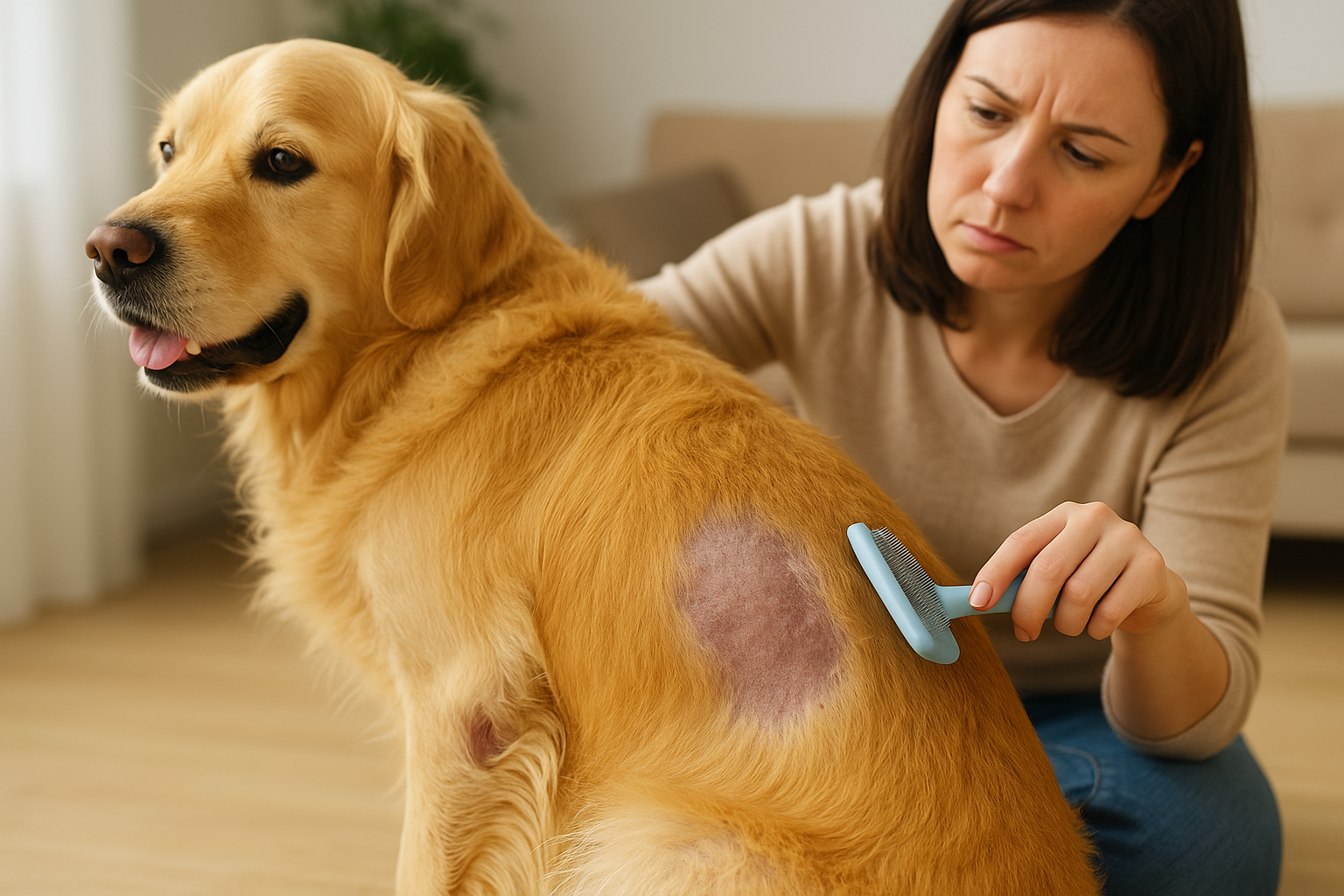

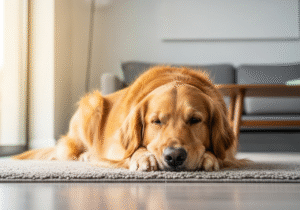
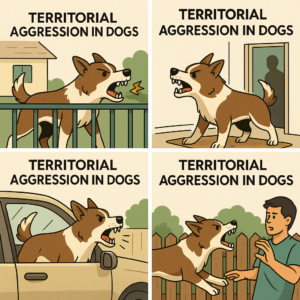
Pingback: Top 8 Digestive Problems in Dogs & Vet-Approved Treatment Tips